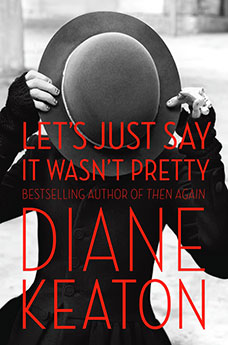Diane Keaton’s sincere musings on beauty
A review of ‘Let’s Just Say it Wasn’t Pretty’ by Diane Keaton
Share
 LET’S JUST SAY IT WASN’T PRETTY
LET’S JUST SAY IT WASN’T PRETTY
By Diane Keaton
For a woman who has spent her entire public life covered up—perennially layered in outsized overcoats, turtlenecks, gloves, scarves, baggy pants, vests and her trademark hats—Diane Keaton is, in print, nakedly candid. In her quasi-memoir Then Again, published three years ago, Keaton dusted lightly over career highlights, opting to instead focus on the familial, platonic and romantic loves that have shaped her world. Though respectful of others’ privacy—particularly such high-profile paramours as Woody Allen, Warren Beatty and Al Pacino—Keaton held nothing back, her every passion, every disappointment, laid bare. Now, with Let’s Just Say It Wasn’t Pretty, the theme shifts to beauty in all its guises, as filtered and refracted through Keaton’s somewhat cockeyed yet invariably intriguing lens.
As is commonly known, Allen modelled Annie Hall closely on Keaton. She herself admits the Oscar-winning role was “a walk in the park.” So it is hardly surprising that, as with the first book, her inherent Annie-ness—a loopy, erratic, rather dishevelled storytelling style—shines delightfully through. Indeed, swaths of Then Again are repeated almost verbatim, most notably, her startling epiphany, during a bra-buying excursion for her teenage daughter at Victoria’s Secret, that the lingerie emporium can be perceived as a mecca of female empowerment.
As a child of the 1950s, growing up in suburban California, Keaton was obsessed with conventional beauty. She yearned to look like Doris Day. And it seems, though she remains one of the most distinctively striking screen stars of her generation, her feelings of physical inadequacy have not diminished. The book’s cover shows her hiding her face behind a bowler, and she reveals that the only body part she’s willing, actually eager, to expose is her feet. (Her barefoot antics having cost her several broken toes and, in one instance, the acute embarrassment of her 13-year-old son.)
Still, she’s never had work done and has reached a shrugged détente with her pervading sags and wrinkles, valuing authenticity over plasticity. She instead defines true beauty in broad, non-physical strokes—her children and friends, thoughtfulness, intelligence, courage, a genuine smile, a good laugh and, more specifically, architectural ingenuity (a serial house-flipper, she’s changed homes 15 times in the past 18 years, including two Frank Lloyd Wrights and a Wallace Neff). Yes, she veers dangerously close to several time-worn tropes, yet Keaton’s off-kilter warmth and heartfelt sincerity ensure her valentines never turn overly mawkish.
CHRISTOPHER LOUDON